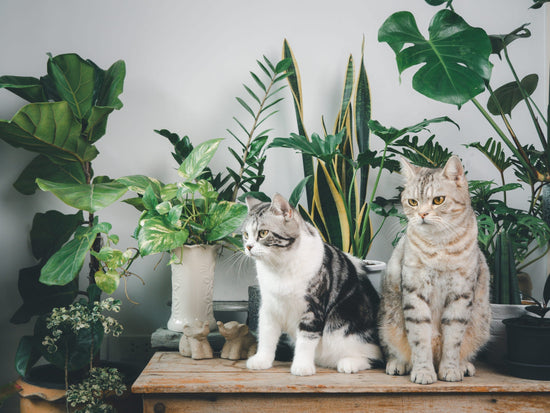Congratulations on your new green roommate—the Alocasia! To ensure you receive optimal care for your plant right from the start, we offer a comprehensive guide to Alocasia care: from the right lighting conditions to the ideal temperature and humidity.
Optimal lighting conditions for Alocasia
The Alocasia, also known as the elephant ear plant, shines in all its glory when surrounded by a generous, high-quality light source. Its ornate leaves unfold best in an environment with sufficient daylight, although you should be careful to avoid direct sunlight to prevent leaf scorch. This way, you'll ensure that your exotic beauty not only thrives but also showcases its distinctive features in shape, color, and texture.
-
Bright, indirect light: Alocasia thrives in a bright location, ideally near a window with sufficient daylight. o you create optimal basic conditions for successful Alocasia care.
-
Avoid direct sunlight: Although the Alocasia loves light, you should avoid direct sunlight. The delicate leaves can be damaged by too much sun. Place the Alocasia in a location protected from intense sunlight, such as behind a light curtain.
-
Choose the optimal positioning: Orient your plant east or west to ensure even light distribution. Rotating the plant every few weeks ensures all leaves receive even light.
- Adapting to the needs: Observe your Alocasia's leaves regularly to see if they're adapting to the light conditions. If the leaves turn yellow or have burn-like spots, this could indicate light problems that need to be adjusted.
Alocasia temperature needs 1x1
As a lover of warm climates, the Alocasia thrives in consistently warm temperatures. Make sure it's placed in a pleasantly warm and stable environment.
-
Consistent warmth: Alocasia plants thrive in an environment with consistent warmth. Ideally, keep the room temperature between 18-25°C to ensure the plant is in a comfortable and conducive environment.
-
Avoid drafts: Protect your Alocasia from drafts, as these plants can be sensitive to sudden air movements. Place them in a location that avoids constant airflow to minimize potential stress.
-
Consider the location: Make sure the plant is not near heaters or air conditioners, which can cause extreme temperature changes.
- Observe the plant: Look for signs of discomfort, such as leaf discoloration or changes and adjust your Alocasia's care or location conditions as needed. A consistently warm environment ensures it stays healthy and can reach its full potential.
Simulate tropical humidity
Since Alocasias originate from tropical regions, they prefer higher humidity. With a few simple tricks and care tips, you can create a pleasant microclimate that will benefit your Alocasia and best mimic its natural habitat.
-
Regular misting: Regularly mist your Alocasia's leaves with water to increase humidity. This simulates the morning dew in tropical regions and creates a pleasant environment.
-
Use a humidifier: Place a humidifier near your Alocasia to ensure a constant source of moisture. This will make care easier and create optimal conditions for healthy growth.
-
Grouping with other plants: Place the Alocasia next to other plants to create a natural grouping. Plants release moisture as they respire and can collectively create a favorable microclimate.
- Watch for symptoms: Observe the Alocasia's leaves for signs of dryness or burning. If the humidity is too low, the leaf tips may turn brown. If this happens, increase the humidity.
The right soil conditions
Choose the right substrate for your Alocasia to promote its healthy development. Ideally, potting soil should be well-drained and retain moisture reliably. A mix with perlite or sand improves soil structure and ensures efficient drainage. This creates ideal conditions for the roots and makes caring for your Alocasia easier by reducing the risk of waterlogging.
Dose irrigation correctly
The Alocasia requires precise dosage when watering. Make sure to keep the soil consistently moist, but without causing waterlogging. A proven method is to allow the top layer of soil to dry out slightly between waterings. This will make your Alocasia feel comfortable and significantly reduce the risk of problems such as root rot caused by excessive moisture.
Support growth with fertilizer
To provide your Alocasia with optimal nutrition and support its growth, we recommend fertilizing regularly throughout spring and summer. You can apply a balanced liquid fertilizer every 4-6 weeks to ensure a continuous supply of nutrients. This timing is crucial, as the plant requires increased nutrients during this period to promote healthy leaf growth and robust development. Make sure to apply the fertilizer according to the instructions on the fertilizer package to ensure optimal nutrition while avoiding overfeeding.
Repotting at the right time
With proper care, your Alocasia can grow rapidly. Therefore, it's advisable to repot it into a larger pot with fresh soil every 1-2 years. This not only supports healthy growth but also allows for renewal of the substrate. Repotting gives the Alocasia more space for its roots, which promotes nutrient uptake and simultaneously improves soil structure. To do this, choose a pot that's about 2-5 cm larger in diameter than the current one and use well-draining soil.
Leaf care for Alocasia
With proper care, your Alocasia will reward you with impressive leaves. But even these require attention: Regular dust removal is crucial for smooth photosynthesis and healthy leaves. Simply use a soft, damp cloth or gently shower your Alocasia at regular intervals.
Step by step to becoming an Alocasia expert
While Alocasia care may seem challenging at first, it's actually not that complicated. With a few simple basics—from the right location and appropriate watering to optimal temperature and humidity—you can nurture your Alocasia beautifully. Every little routine brings you closer to a healthy, impressive plant that you can enjoy for a long time.





